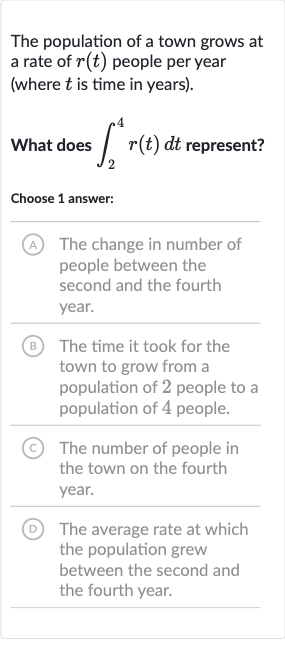AI tutor
Welcome to Bytelearn!
Let’s check out your problem:

The population of a town grows at a rate of people per year (where is time in years).What does represent?Choose answer:(A) The change in number of people between the second and the fourth year.(B) The time it took for the town to grow from a population of people to a population of people.(C) The number of people in the town on the fourth year.(D) The average rate at which the population grew between the second and the fourth year.
Full solution
Q. The population of a town grows at a rate of people per year (where is time in years).What does represent?Choose answer:(A) The change in number of people between the second and the fourth year.(B) The time it took for the town to grow from a population of people to a population of people.(C) The number of people in the town on the fourth year.(D) The average rate at which the population grew between the second and the fourth year.
- Understand Population Growth Integral: Understand the integral in the context of population growth.The integral of a rate function over an interval gives the net change in the quantity over that interval. In this case, represents the rate of population growth per year, and the integral from to of represents the total change in population from year to year .
- Analyze Answer Choices: Analyze the answer choices in relation to the integral.(A) The integral from to of calculates the total change in population between year and year , which is the net increase in the number of people.(B) The integral does not represent the time it took for the town to grow; it represents the change in population over a specific time period.(C) The integral does not give the number of people in the town at a specific time; it gives the change in population over a time interval.(D) The integral does not represent an average rate; it represents the total change in population over the time interval.
- Choose Correct Answer: Choose the correct answer based on the analysis.Based on the understanding of the integral and the analysis of the answer choices, the correct answer is:(A) The change in number of people between the second and the fourth year.
More problems from Write a linear function: word problems
QuestionGet tutor help
QuestionGet tutor help
QuestionGet tutor help
QuestionGet tutor help
QuestionGet tutor help
QuestionGet tutor help
QuestionGet tutor help
QuestionGet tutor help
QuestionGet tutor help
